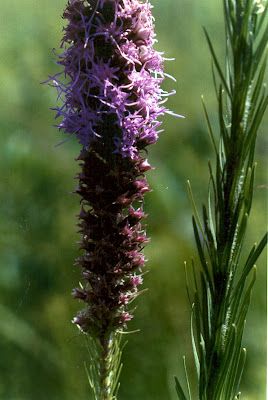To identify which you have, start by putting them into two groups.
Plants with flowers crowded into a long spike....2 species
Plants with flower heads separate from each other, or in small clusters scattered along stem....4 species.
You have to look at the phyllaries or bracts under the flower head. On spicata, the bracts are flat and stay appressed against one another.
Occasionally you will find the alba form of Spiked Blazing Star. These are often sought after by gardeners, and commonly sold at nurseries.
The other similar looking species is the Prairie Blazing Star, Liatris pycnostchya. Overall, this plant is hairy on the leaf and stem, but as I mentioned, I don't rely on that.
As before, examine the flower up close. In pycnostachya, the bracts don't lay flat, but are recurved.
The other four species present a greater challenge. You can see how the flower heads are larger, rounder, and spread apart like balls of chewed bubble gum. While this isn't a good picture, it does give you an idea of its smaller size. This is Dwarf Blazing Star, Liatris cylindracea. The two spiked species can reach 5 feet in height, but this species may grow only 2 feet.
I think you'll see a theme here. You have to look at the bracts on ALL of the Blazing Stars. L. cylindracea has bracts that are sharply pointed and end in a thorn like mucronate tip. To me this species also looks to have narrow flower heads, like maroon corn on the cob. All of the Blazing Stars are planted in prairie plots today, but historically this species was restricted to a few southern counties here in Ohio.
When I see this species, it looks as if it has been beaten down or windblown, in other words, a loose scraggly appearance. Of course botanically that means nothing. This small to medium sized species is the Scaly Blazing Star, Liatris squarrosa. The bracts are long pointed or scaly, and project or spread outward from the flowerhead. The rest of the plant is highly variable. The flowers can be large or small, many or few, the flower stalk long or short, and the stem and leaves hairy or smooth. Stick to the bracts!
The last two species are the hardest to separate, at least for me. Both are medium to large species. I've seen them at least 4 foot tall in Iowa prairies. Both have robust rounded flower heads. This one is the Rough Blazing Star, Liatris aspera. The bracts are not pointed but round, and look like swollen lips. If you have a hand lens, look at the edge of each bract. They have an obvious fringe on them. Also look at how the flowers are sessile, or nearly so with a very short stalk. The leaves below the flowers are very narrow or thin, and this tends to be the case all the way down the stem.
Last but not least are these three pics of Liatris scariosa. Common names include Eastern, Northern, or Blue Blazing Star. The native range in Ohio for this and the previous species are a few southern counties, and the counties surrounding the Oak Openings near Toledo. The characters I use to separate this from aspera are first the bracts. These are rounded with a smooth looking rim. A hand lens may reveal a very fine lace like edge. The bracts lay flat, like a thumb print, and are not swollen. They turn from green to maroon red. The flower stalks are also red and much longer than aspera. The leaves are not as thin, but broader throughout the plant stem.

















Very helpful, thank you!
ReplyDelete